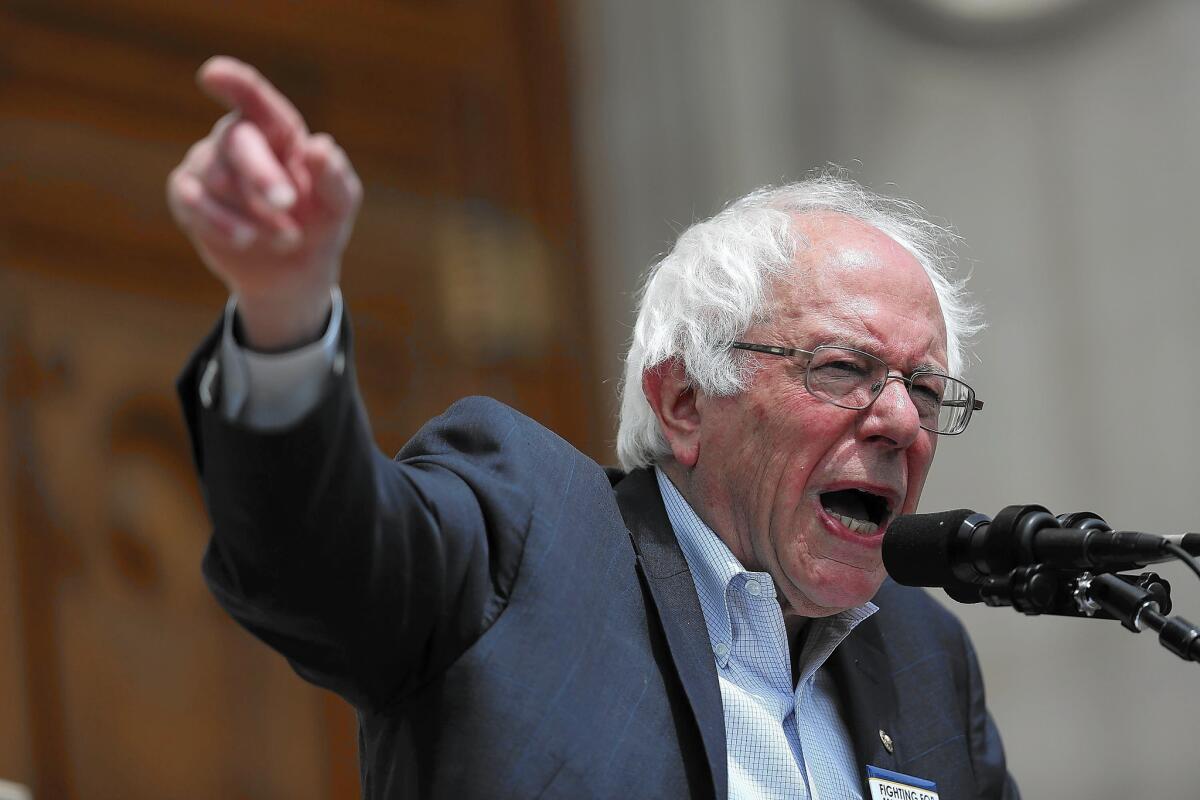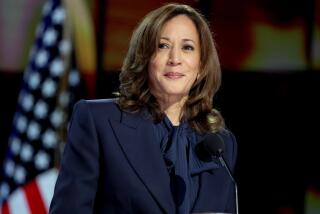Bernie Sanders supporters strategizing to build a lasting progressive movement

Reporting from INDIANAPOLIS — The eclectic mix of labor loyalists, gay rights advocates, antiwar protesters and political neophytes who gathered in a union hall here a few days ago may have never ended up in the same room together were it not for Bernie Sanders.
And they wondered whether they would ever come together again with this much excitement about a common goal.
As the prospect of the democratic socialist they adore winning the White House rapidly fades, Sanders supporters are scrambling to keep the movement he has built from fading like earlier liberal efforts have.
It may not be easy lightning to contain.
Bernie Sanders is “the glue that holds us together,” said Phil Sanders, a gray-ponytailed onetime peacenik at the union hall rally here who has been protesting since Vietnam.
The activist, no relation to the candidate, is eager to see the movement that Sanders spawned continue to grow after election day. But he worries that the Sanders phenomenon will end up as more of a moment than a movement. Aside from supporting Sanders, he said, the different elements in the coalition are “all off on different things,” with passions as diverse as a $15 minimum wage and climate change.
Progressives have been here before. They went through it with Howard Dean, with Jesse Jackson, with Ralph Nader, with Jerry Brown. Each of those outsider candidates captured a populist enthusiasm during the race that energized millions, many of them altogether new to politics — but then struggled to keep it all intact once the galvanizing force of a presidential run was gone.
With that history in mind, a campaign behind the Sanders campaign is starting to take shape, with the goal of turning his passionate army into something that doesn’t end after he delivers a barn-burning convention speech in Philadelphia — and then gets overshadowed by a general election in which he is unlikely to be on the ballot.
“This is a hard conversation for many of us to have,” said an open letter to Sanders written by Bronx teacher and union organizer Erik Forman, and signed by dozens of activists and academics, including Noam Chomsky. “We’ve been hurt before. ... We want this time to be different. Let’s build something real together. Let’s make not just a political revolution, but a social and economic revolution by building not just a campaign for president, but a lasting movement.”
The letter lays out a plan for building a lasting advocacy organization that would rival the tea party or the National Rifle Assn. by leveraging Sanders’ massive donor network and grass-roots organizing operation to win local-level elections and push a progressive agenda. Other Sanders supporters are meeting in Chicago in June to map out a plan for continuing the fight.
The activists face some complicated choices. The first is whether they even want to stay in the Democratic Party, which many Sanders supporters complain is in thrall to wealthy donors and corporate interests and cannot be trusted.
“It’s been kind of hard for me to work with Democrats,” said Amanda Marsh, 46, a longtime activist. “That party would have to have a complete paradigm shift, and they would have to totally change for me to be a Democrat.”
It’s all familiar to Jackson, who warns against splitting with the party.
“They have to decide if they want to expand the party, or break it to make their point,” he said in an interview. Jackson and his supporters worked with the party for change after building the National Rainbow Coalition following his 1984 run for president.
The coalition-building lacked the thrill of Jackson’s presidential campaigns, but he says it has helped push the Democratic Party left.
“We took the position that we should reengage with Cuba,” Jackson said. “That is now law. We said there should be a two-state solution in the Middle East. That’s now law.” (Neither is enshrined in law, though both are U.S. policy.)
Yet the ideals of the campaign often collide with the machinations of policymaking as leaders seek to keep their supporters motivated once an election is over, even one they win.
Dean, the former Vermont governor, said that became a problem for the network of activists President Obama harnessed once he was in office. “In order to get anything done, you have to focus on nuance, and activists don’t do nuance well,” Dean said.
When Dean’s populist 2004 presidential campaign folded, many of its organizers channeled their energy into spawning a group called Democracy For America. Dean says it has been effective in pushing progressive policies, pointing to various fights in which it has mobilized large numbers of activists and marshaled substantial cash resources.
But for many Sanders supporters, such organizations are a poor replacement for the kind of passionate calling the campaign has become for them.
“There’s definitely hope to coalesce into a larger movement,” said Aaron Robinson, a stay-at-home dad who organized the event Thursday night at an International Brotherhood of Electrical Workers hall. “The challenge at this point is what that direction will be.”
Historians say the kind of broad-based, enduring movement that Sanders supporters envision rarely grows out of a presidential campaign, but it can happen. President Reagan rebuilt the conservative movement. Eugene McCarthy had his crusade against the Vietnam War.
Sanders’ movement is so broad, and its policy goals so diffuse, that it will be difficult to keep the momentum.
“Bernie Sanders’ candidacy is a simple symbol for a whole range of concerns and commitments,” said David Meyer, a professor of sociology and political science at UC Irvine. “Once his candidacy is no longer around, it is hard for regular people to visualize it and harder for mass media to cover.
“Usually, after the candidacy ends, public attention turns.”
But some of the Sanders faithful say this moment feels different. “This is the new Democratic base,” said attorney Paul Logan. “I don’t think that’s going to end, no matter what form it takes.”
Some of the people drawn to Sanders will end up working to elect progressives to local office and Congress, predicted Kathleen Calhoun, 34, a freelance editor and Starbucks manager. If nothing else, she said, Sanders showed it was possible to mount a credible campaign from the outside, while attacking a political system dominated by the rich.
“That’s a miracle,” she said. “There’s not been anybody like that.”
Tanfani reported from Indianapolis and Halper from Washington.
ALSO
Indiana relishes its surprising spotlight in the GOP race
How Donald Trump scored a win in Texas border country
Obama drops the mic at his last White House Correspondents’ Dinner as president
More to Read
Get the L.A. Times Politics newsletter
Deeply reported insights into legislation, politics and policy from Sacramento, Washington and beyond. In your inbox three times per week.
You may occasionally receive promotional content from the Los Angeles Times.












